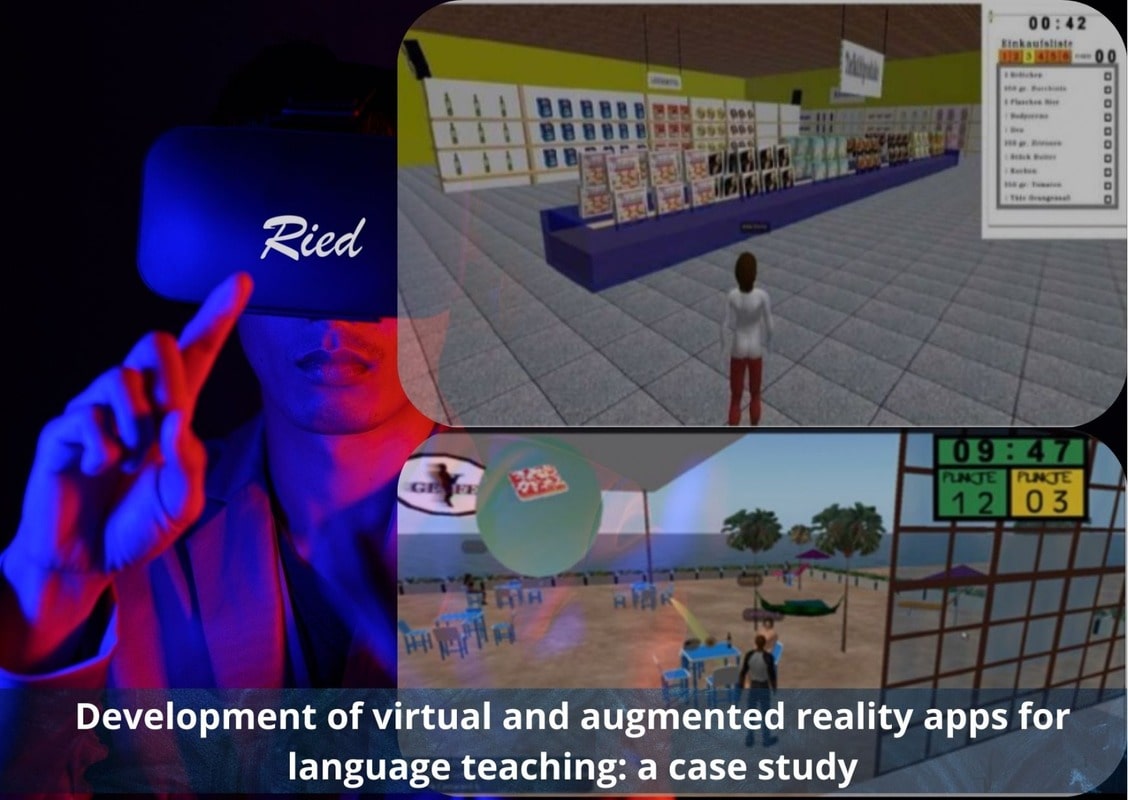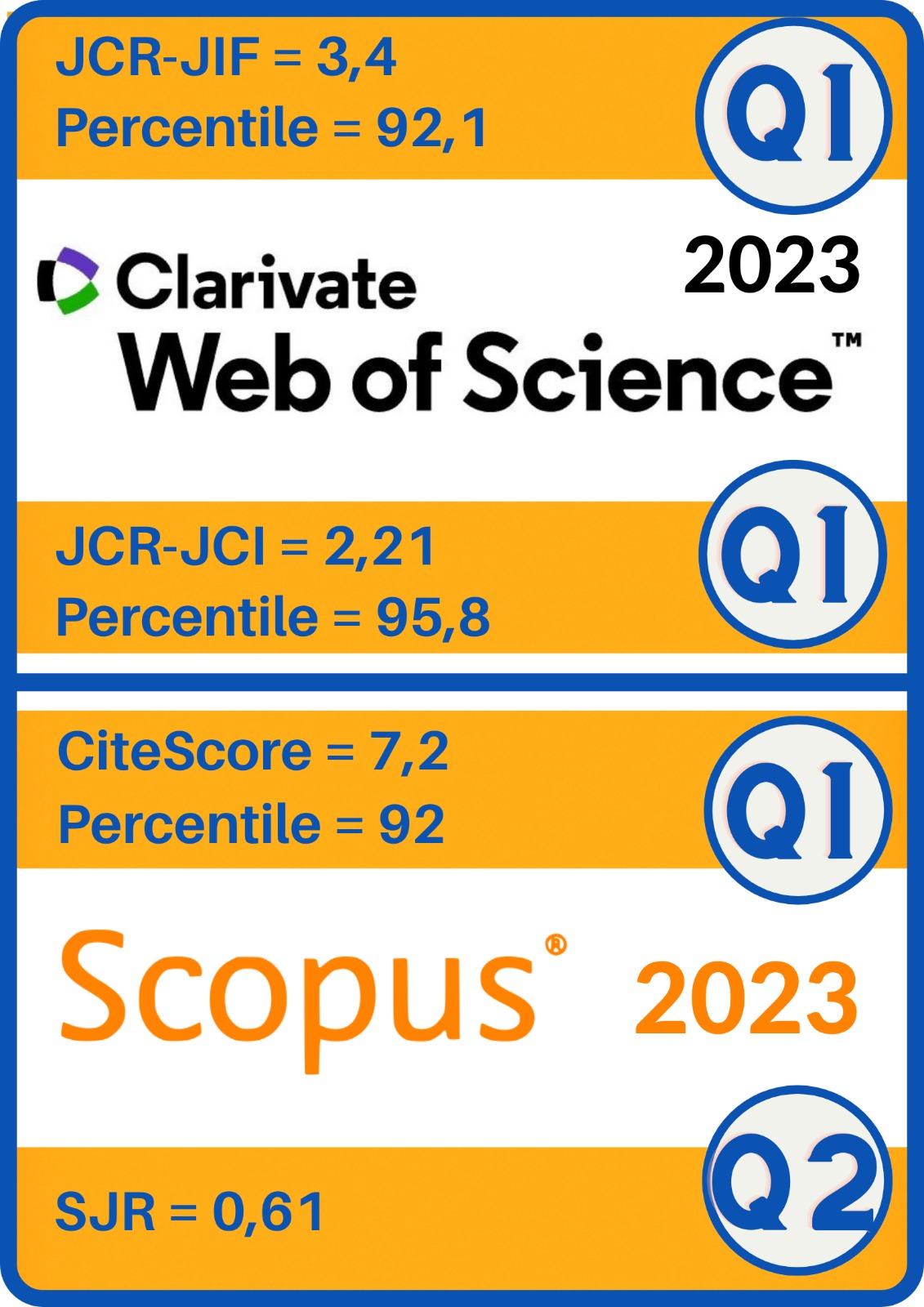Desarrollo de apps de realidad virtual y aumentada para enseñanza de idiomas: un estudio de caso
DOI:
https://doi.org/10.5944/ried.27.1.37668Palavras-chave:
tecnología de la educación, nuevas tecnologías, ética, enseñanza de idiomas, estudios universitarios, estudio de casoResumo
Los avances tecnológicos de las últimas décadas y su creciente accesibilidad, suponen para los docentes un reto permanente. El presente trabajo se basa en nuestra propia experiencia con el uso de herramientas digitales para la enseñanza de idiomas, concretamente para el alemán como lengua extranjera. Se muestra cómo hemos respondido a las tendencias digitales de los últimos años en el ámbito educativo, incorporando progresivamente recursos tecnológicos para facilitar a nuestros estudiantes la adquisición de conocimientos y destrezas lingüísticas. Integrar estos recursos, sin tener conocimientos de programación y sin el constante apoyo de personal informático, nos ha llevado a explorar y usar herramientas de desarrollo, convirtiéndonos de usuarios de las tecnologías en desarrolladores de nuestras propias apps de Realidad Virtual (RV) y Realidad Aumentada (RA). En este contexto, se presenta un caso de estudio llevado a cabo con 72 estudiantes universitarios, en el que se analiza y compara el potencial educativo y motivador de dos apps creadas recientemente por los autores de este artículo con CoSpaces y ARTutor. Como instrumento de investigación se utilizó un cuestionario basado en el Technology Acceptance Model de Davis (1989), realizando con SPSS V27 un análisis estadístico de la información obtenida. Los resultados manifiestan la idoneidad y el enorme potencial de las apps desarrolladas, no existiendo entre ellas diferencias significativas con respecto a la utilidad o al potencial motivador (Test de Wilcoxon). El uso prolongado de estas apps nos permitirá analizar su impacto frente a otros recursos y diseñar las posibles mejoras.
ARTÍCULO COMPLETO:
https://revistas.uned.es/index.php/ried/article/view/37668/28018
Downloads
Referências
Aljawarneh, S. A. (2020). Reviewing and exploring innovative ubiquitous learning tools in higher education. Journal of Computing in Higher Education, 32, 57-73. https://doi.org/10.1007/s12528-019-09207-0
Aydin, S. (2023). Teachers' Perceptions of the Use of the Metaverse in Foreign Language Teaching and Learning. In G. Durak & S. Cankaya, (Eds.), Shaping the Future of Online Learning: Education in the Metaverse (pp. 201-219). IGI Global. https://doi.org/10.4018/978-1-6684-6513-4.ch011
Balderas, A., Berns, A., Palomo-Duarte, M., Dodero, J. M., & Ruiz-Rube, I. (2017). Retrieving objective indicators from student logs in virtual worlds. Journal of Information Technology Research (JITR), 10(3), 69-83. https://doi.org/10.4018/JITR.2017070105
Baena-Pérez, R., Ruiz-Rube, I., Mota, J. M., Berns, A., & Balderas, A. (2022). Visual authoring of virtual reality conversational scenarios for e-learning. Universal Access in the Information Society, 1-18. https://doi.org/10.1007/s10209-022-00934-3
Berns, A., Gonzalez-Pardo, A., & Camacho, D. (2013). Game-like language learning in 3-D virtual environments. Computers & Education, 60(1), 210-220. https://doi.org/10.1016/j.compedu.2012.07.001
Burston, J., & Giannakou, K. (2022). MALL language learning outcomes: A comprehensive meta-analysis 1994–2019. ReCALL, 34(2), 147-168. https://doi.org/10.1017/S0958344021000240
Canto, S., de Graaff, R., & Jauregi, K. (2014). Collaborative tasks for negotiation of intercultural meaning in virtual worlds and video-web communication. In M. González-Lloret & L. Ortega, (Eds.), Technology-mediated TBLT: Researching technology and tasks (pp. 183-212). John Benjamins. https://doi.org/10.1075/tblt.6
Chartrand, R. (2012). Social networking for language learners: Creating meaningful output with Web 2.0 tools. Knowledge Management & E-Learning, 4(1), 97. https://doi.org/10.34105/j.kmel.2012.04.009
Czepielewski, S., Christodoulopoulou, C., Kleiner, J., Mirinaviciute, W., & Valencia, E. (2011). Virtual 3D tools in online language learning. In S. Czepielewski, (Ed.), Learning a Language in Virtual Worlds. A Review of Innovation and ICT in Language Teaching Methodology. V-lang (pp. 7-14). Warsaw Academy of Computer Science, Management and Administration.
Davis, F. D. (1989). Perceived usefulness, perceived ease of use, and user acceptance of information technology. MIS Quarterly, 13(3), 319-340. https://doi.org/10.2307/249008
Dobre, I. (2015). Learning Management Systems for higher education-an overview of available options for Higher Education Organizations. Procedia-Social and Behavioral Sciences, 180, 313-320. https://doi.org/10.1016/j.sbspro.2015.02.122
García Aretio, L. (2019). Necesidad de una educación digital en un mundo digital. RIED-Revista Iberoamericana de Educación a Distancia, 22(2), 9-22. https://doi.org/10.5944/ried.22.2.23911
Garrido-Iñigo, P., & Rodríguez-Moreno, F. (2015). The reality of virtual worlds: Pros and cons of their application to foreign language teaching. Interactive Learning Environments, 23(4), 453-470. https://doi.org/10.1080/10494820.2013.788034
Heil, C. R., Wu, J. S., Lee, J. J., & Schmidt, T. (2016). A review of mobile language learning applications: Trends, challenges, and opportunities. The EuroCALL Review, 24(2), 32-50. https://doi.org/10.4995/eurocall.2016.6402
Hua, C., & Wang, J. (2023). Virtual reality-assisted language learning: A follow-up review (2018-2022). Frontiers in Psychology, 14, 1-13. https://doi.org/10.3389/fpsyg.2023.1153642
Isla-Montes, J.-L., Berns, A., Palomo-Duarte, M., & Dodero, J.-M. (2022). Redesigning a Foreign Language Learning Task Using Mobile Devices: A Comparative Analysis between the Digital and Paper-Based Outcomes. Applied Sciences, 12, 5686. https://doi.org/10.3390/app12115686
Jabbari, N., & Eslami, Z. R. (2019). Second language learning in the context of massively multiplayer online games: A scoping review. ReCALL, 31(1), 92-113. https://doi.org/10.1017/S0958344018000058
Jauregi, K., & Canto, S. (2012). Enhancing meaningful oral interaction in Second Life. Procedia-Social and Behavioral Sciences, 34, 111-115. https://doi.org/10.1016/j.sbspro.2012.02.023
Jauregi-Ondarra, K., & Canto, S. (2022). Interaction games to boost intercultural communication in virtual worlds and video-communication: A case study. In M. Peterson & N. Jabbari, (Eds.), Digital Games in Language Learning (pp. 158-182). Routlegde. https://doi.org/10.4324/9781003240075
Karakaya, K., & Bozkurt, A. (2022). Mobile-assisted language learning (MALL) research trends and patterns through bibliometric analysis: Empowering language learners through ubiquitous educational technologies. System, 102925. https://doi.org/10.1016/j.system.2022.102925
Krashen, S. (2003). Explorations in language acquisition and use. Heinemann.
Kukulska‐Hulme, A., & Viberg, O. (2018). Mobile collaborative language learning: State of the art. British Journal of Educational Technology, 49(2), 207-218. https://doi.org/10.1111/bjet.12580
Lazar, S., & Milena, B. (2013). M-learning-a new form of learning and education. International Journal of Cognitive Research in Science, Engineering and Education, 1(2), 114-118.
Levy, M., & Stockwell, G. (2013). CALL dimensions: Options and issues in computer-assisted language learning. Routledge. https://doi.org/10.4324/9780203708200
López-Belmonte, J., Moreno-Guerrero, A.-J., López-Núñez, J.-A., & Pozo-Sánchez, S. (2021). Scientific production of flipped learning and flipped classroom in Web of Science. Texto Livre: Linguagem e Tecnologia, 14(1), 1-26. https://doi.org/10.35699/1983-3652.2021.26266
López-Belmonte, J., Pozo-Sánchez, S., Moreno-Guerrero, A.-J., & Lampropoulos, G. (2023). Metaverso en Educación: una revisión sistemática. Revista de Educación a Distancia (RED), 23(73). https://doi.org/10.6018/red.511421
Melchor-Couto, S. (2017). Foreign language anxiety levels in Second Life oral interaction. ReCALL, 29(1), 99-119. https://doi.org/10.1017/S0958344016000185
Molka-Danielsen, J., & Deutschmann, M. (2009). Learning and teaching in the virtual world of Second Life. Tapir Academic Press.
Neumann, A. T., Arndt, T., Köbis, L., Meissner, R., Martin, A., De Lange, P., Pengel, P., Klamm, R., & Wollersheim, H. W. (2021). Chatbots as a tool to scale mentoring processes: Individually supporting self-study in higher education. Frontiers in Artificial Intelligence, 4, 668220. https://doi.org/10.3389/frai.2021.668220
Palomo-Duarte, M., Berns, A., Cejas, A., Dodero, J. M., Caballero-Hernández, J. A., & Ruiz-Rube, I. (2018). A Community-Driven Mobile System to Support Foreign Language Learning. In V. Ahuja & S. Rathore, (Eds.), Multidisciplinary Perspectives on Human Capital and Information Technology Professionals (pp. 95-115). IGI Global. https://doi.org/10.4018/978-1-5225-5297-0.ch006
Parmaxi, A., & Demetriou, A. A. (2020). Augmented reality in language learning: A state‐of‐the‐art review of 2014–2019. Journal of Computer Assisted Learning, 36(6), 861-875. https://doi.org/10.1111/jcal.12486
Parmaxi, A. (2023). Virtual reality in language learning: A systematic review and implications for research and practice. Interactive Learning Environments, 31(1), 172-184. https://doi.org/10.1080/10494820.2020.1765392
Peterson, M. (2016). The use of massively multiplayer online role-playing games in CALL: An analysis of research. Computer Assisted Language Learning, 29(7), 1181-1194. https://doi.org/10.1080/09588221.2016.1197949
Romano, M., Díaz, P., & Aedo, I. (2020). Empowering teachers to create augmented reality experiences: the effects on the educational experience. Interactive Learning Environments, 31(3), 1546-1563. https://doi.org/10.1080/10494820.2020.1851727
Souabi, S., Retbi, A., Idrissi, M. K., & Bennani, S. (2021). Towards an Evolution of E-Learning Recommendation Systems: From 2000 to Nowadays. International Journal of Emerging Technologies in Learning (iJET), 16(06), 286-298. https://doi.org/10.3991/ijet.v16i06.18159
Southgate, E., Smith, Sh. P., Cividino, Ch., Saxby, Sh., Kilham, J., Eather, G., Scevak, J., Summerville, D., Buchanan, R., & Bergin, C. (2019). Embedding immersive virtual reality in classrooms: Ethical, organisational and educational lessons in bridging research and practice. International Journal of Child-Computer Interaction, 19, 19-29. https://doi.org/10.1016/j.ijcci.2018.10.002
Tavakoli, R., & Wijesinghe, S. N. (2019). The evolution of the web and netnography in tourism: A systematic review. Tourism Management Perspectives, 29, 48-55. https://doi.org/10.1016/j.tmp.2018.10.008
Terzopoulos, G., Kazanidis, I., Satratzemi, M., & Tsinakos, A. (2021). A Comparative Study of Augmented Reality Platforms for Building Educational Mobile Applications. In M. E. Auer & T. Tsiatsos, (Eds.), Internet of Things, Infrastructures and Mobile Applications. IMCL 2019. Advances in Intelligent Systems and Computing, 1192 (pp. 307-316). Springer. https://doi.org/10.1007/978-3-030-49932-7_30
UN (2019). Informe de los Objetivos de Desarrollo Sostenible 2019. https://unstats.un.org/sdgs/report/2019/The-Sustainable-Development-Goals-Report-2019_Spanish.pdf
UNESCO (2018). Designing inclusive digital solutions and developing digital skills. https://unesdoc.unesco.org/ark:/48223/pf0000265537
Vert, S., & Andone, D. (2019). Virtual reality authoring tools for educators. In N. Herisanu, M. Razzaghi, & R. Vasiu, (Eds.), ITM web of conferences, 29 (pp. 1-7). EDP Sciences. https://doi.org/10.1051/itmconf/20192903008
Xie, H., Chu, H. C., Hwang, G. J., & Wang, C. C. (2019). Trends and development in technology-enhanced adaptive/personalized learning: A systematic review of journal publications from 2007 to 2017. Computers & Education, 140, 103599. https://doi.org/10.1016/j.compedu.2019.103599
Zalite, G. G., & Zvirbule, A. (2020). Digital readiness and competitiveness of the EU higher education institutions: The COVID-19 pandemic impact. Emerging Science Journal, 4(4), 297-304. https://doi.org/10.28991/esj-2020-01232

Downloads
Publicado
Como Citar
Edição
Secção
Licença
Direitos de Autor (c) 2023 Concepcion Valero Franco, Anke Berns

Este trabalho encontra-se publicado com a Licença Internacional Creative Commons Atribuição 4.0.
As obras que são publicadas neste revista estão sujeitas ao seguintes termos:
1. Os autores cedem de forma não exclusiva os direitos de exploração dos trabalhos aceitos para sua publicação a "RIED. Revista Iberoamericana de Educação a Distância", garantem à revista o direito de ser a primeira publicação do trabalho e permitem que a revista distribua os trabalhos publicados sob a licença de indicada no ponto 2.
2. As obras são publicadas na edição eletrônica da revista sob uma licença Creative Commons Atribuição 4.0 Internacional (CC BY 4.0). Podem copiar e redistribuir o material em qualquer suporte ou formato, adaptar, remixar, transformar, e criar a partir do material para qualquer fim, mesmo que comercial. Você deve atribuir o devido crédito, fornecer um link para a licença, e indicar se foram feitas alterações. Você pode fazê-lo de qualquer forma razoável, mas não de uma forma que sugira que o licenciante o apoia ou aprova o seu uso.
3. Condições de auto-arquivo. Permite-se e incentava-se aos autores difundir eletronicamente a versõ OnlineFirst (versão avaliada e aceita para publicação) de su obra antes de sua publicação, sempre com referência a sua publicação na RIED, já que favorece sua circulação e difusão mais cedo e com isso um possível aumento em sua citação e alcance entre a comunidade acadêmica. Color RoMEO: verde.







